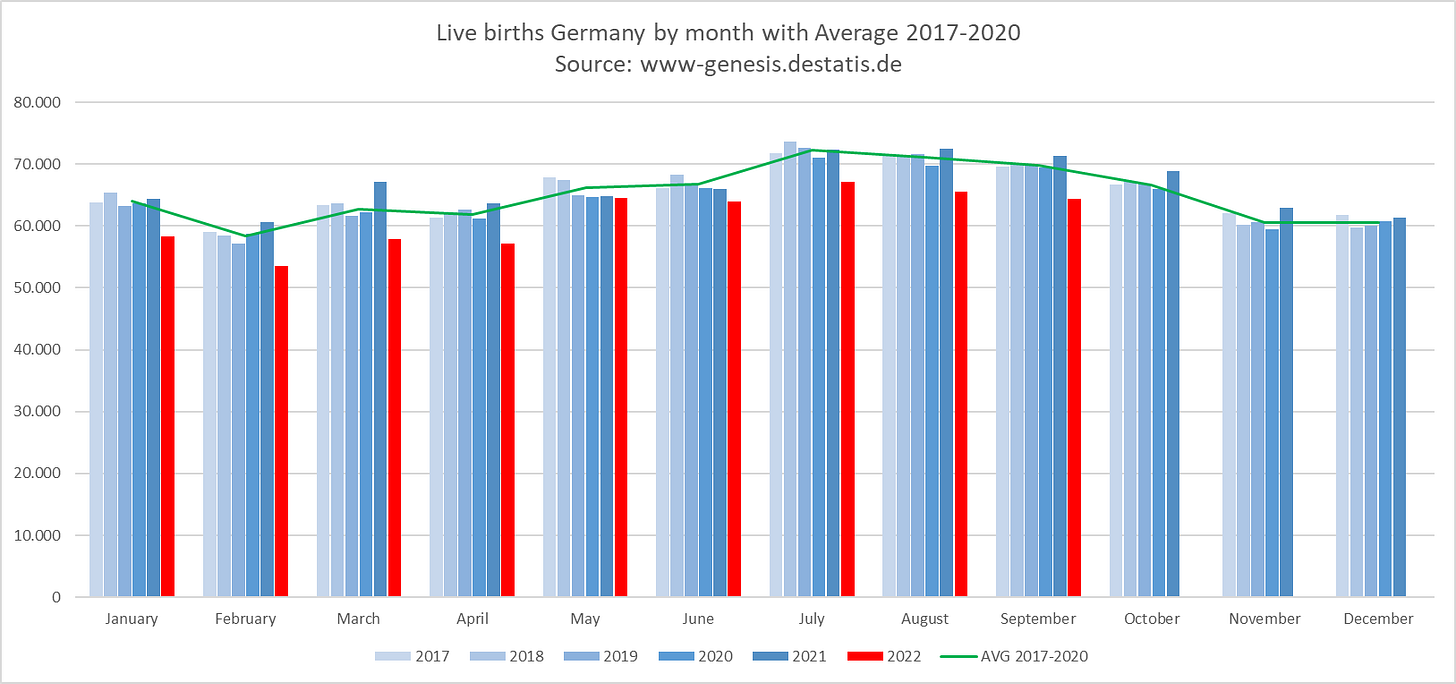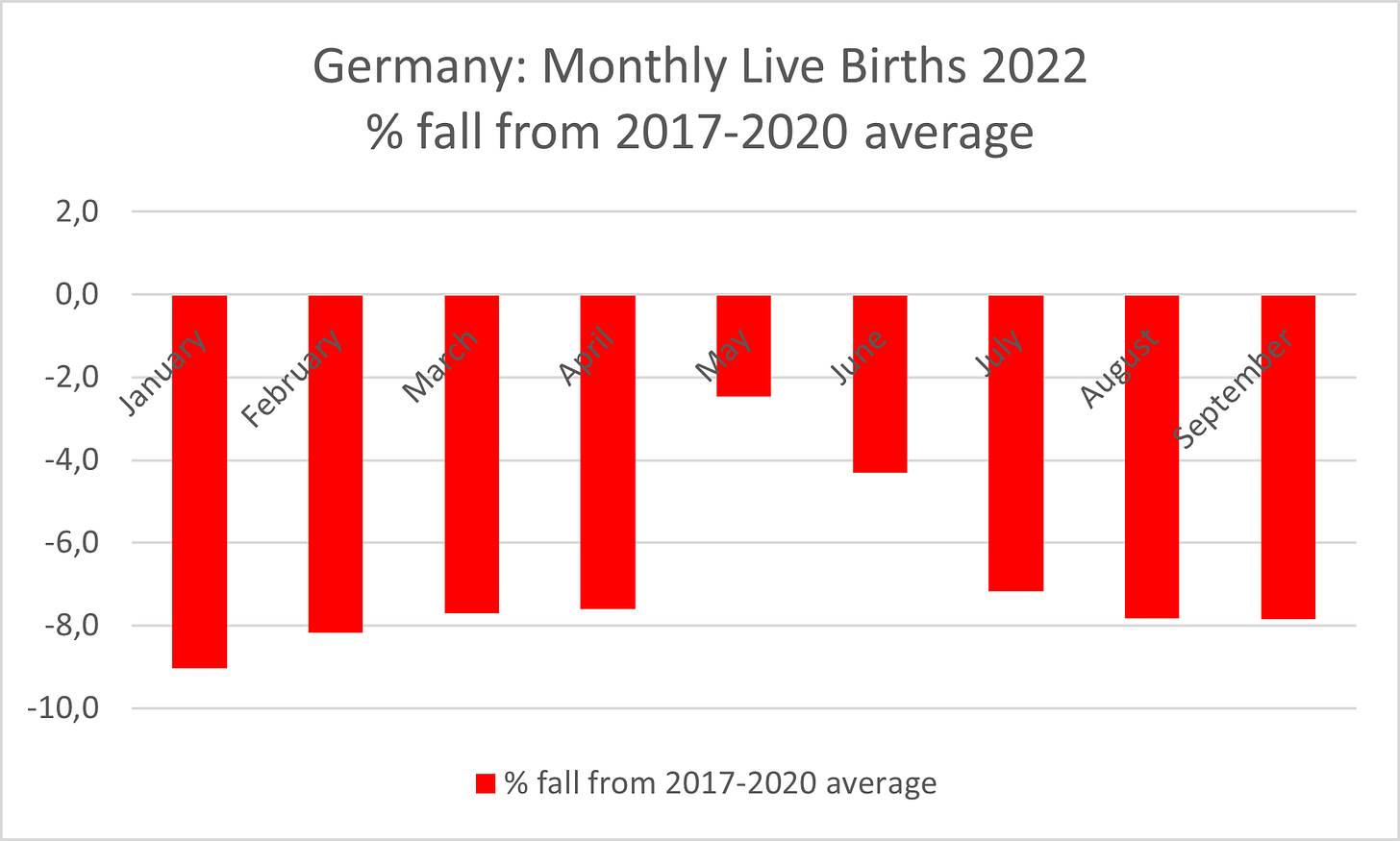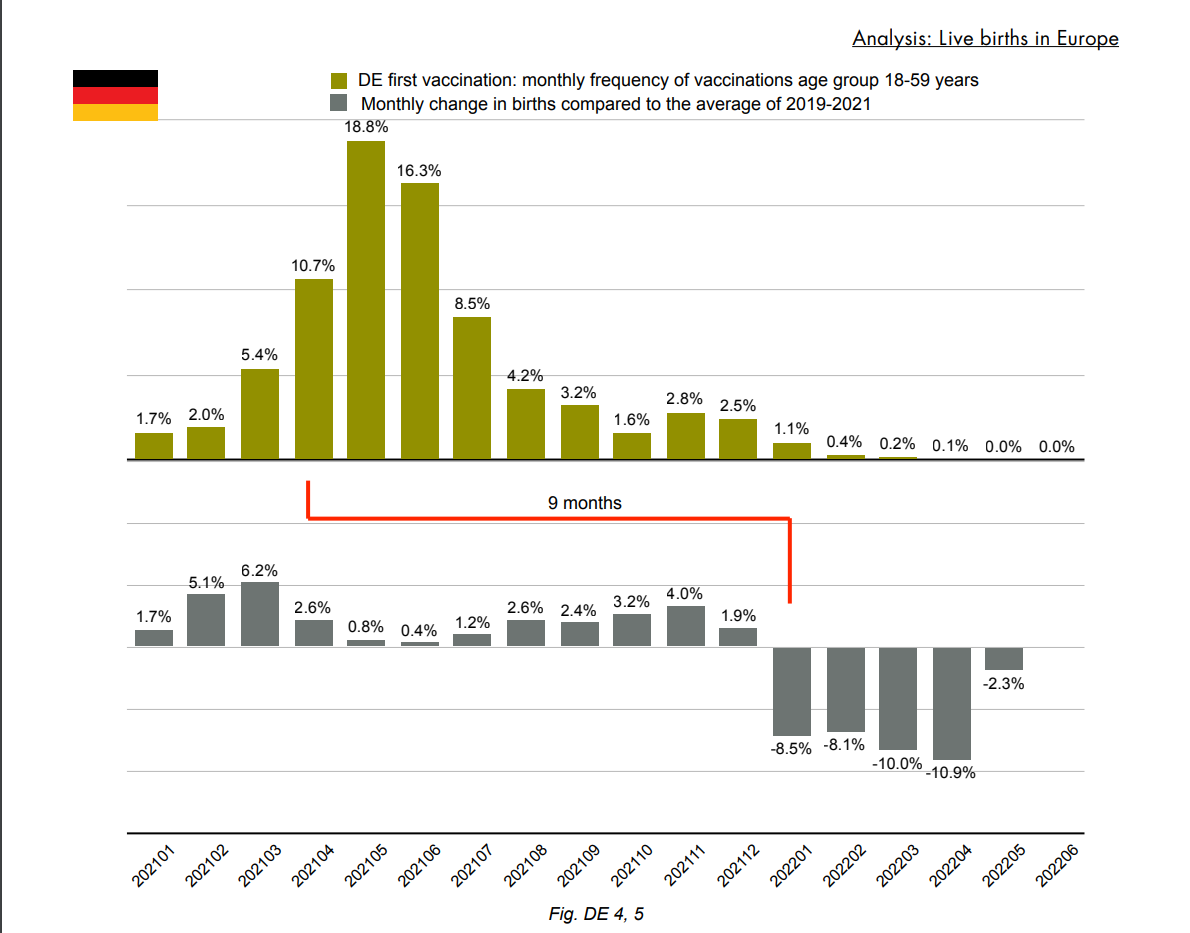Significant drop in German births continues and continues..
No end in sight for unprecedented fall in live births in Germany 2022
It’s been a quite a while since my previous post on the German births situation. Summer holidays are long gone, autumn’s glory has faded and here in my cold corner of south Germany sky rocketing heating bills and masses of kids getting infections are the main news. Today is the winter solstice for us here in the northern hemisphere - the longest night. Meanwhile, the unprecedented fall in live births in Germany continues unabated.
(There is also the small matter of the remarkably consistent monthly German excess mortality this year but, hey, apart from a few cursory articles, the MSM sees no reason to blare any of these exceptional births and deaths numbers in headlines like they did for the numbers of corona infections and deaths.)
My lack of posting is mostly due to there being no significant change in the births situation, which in itself remains equally puzzling. The Federal Statistics Agency has released live births data up to September 2022 and there is still no sign of a recovery: live births remain significantly lower than the normal range for the past years
German births over the past years have followed a very regular annual pattern: births peak in summer (July) and are their lowest in winter (February) with a curious mini bump in January interrupting the winter low. Births in 2022 have followed a very similar pattern (minus the January blip phenomenon) but at a consistently lower level. Below I have illustrated this is with the monthly totals from 2017-2022 grouped by calendar month and displayed with the pre-pandemic average for 2017-2020 (green)
It is very easy to see the significant departure in 2022 from the normal pre-pandemic range. Note, there was a somewhat momentary recovery in the birth figures into a more normal range for May with comparable numbers to ‘19 and ‘20 (perhaps corresponding to 9 months after Aug ‘21 when the initial vaccination campaign push in adults was at an absolute minimum?, but births fall off once again to a consistent level of about 8% below the pre-pandemic average. [CORRECTION: updated June births may also indicative of reduced effect corresponding to late summer August-September low in vaccination programme]
And here the correlation seems to flounder. For example, there does not seem to be any signal [CORRECTION: is there now a signal in May-June births 9 months after late summer low in vaccinations?] from the intensive booster campaign with started in November 2021 (although child-bearing ages would have begun in earnest in December) and was effectively done by February ‘22. I had planned a post expecting a signal to appear in the August figures which, for me, would correspond to 8 months after the rollout of the booster campaign in younger cohort. Please see my post “Menstrual changes & (very) early miscarriages” if you are wondering why I suspected a shorter delay of 8 months and not the more intuitive 9 months for the first signs of disruptions in live birth figures.
Instead, the decline in births has remained remarkably steady (exluding May [CORRECTION: and June) thus the data is overall neither indicative of a compunding affect on fertility - i.e. declines have not worsened the more people were vaccinated (or the more doses they received) nor are is there evidence of larger declines corresponding to the vaccination campaigns in the 2nd and 4th quarters of ‘21.
The above distribution of the the doses administered should also make abundantly clear why there should be a strong signal from the booster campaign IF the correlation with the vaccination campaign is the key to understanding the fall in live births, or so I had thought. Then I scratched my head to imagine a mechanism that could fit the data: what if each vaccine dose brings with it an extended period of reduced fertility?
Most vaccinees received 3 doses over a period of 9 months: 1st dose is day zero; 2nd dose 1~2 months later; 3rd dose ~6 months later. Would this offer a possible explanation for the sudden and then continued drop? For example, if the affect on fertility is ~4 months per dose, then the first 2 doses combined would create a 5~6 month of reduced fertility followed by a brief respite before the booster would introduce another 4 month period of reduced fertility. In which case the effect would subside ~4 months after the booster campaign. An additional 9 months results in a 13 month period after the booster campaign before live birth figures would recover. This suggests 2nd quarter 2023 might be when we see a recovery in the live births to pre-pandemic levels.
Alternatively (and perhaps most disturbingly) might a subsection of women have had their fertility permanently affected? We’ll just have to wait and see… And yes, I still say, IF, because this is still not a case-closed situation for me, read on:
Other reports on the decline in births:
Data from some countries with similar rates of vaccination to Germany’s certainly buck the trend, most notably Germany’s immediate neighbour, France. Substacker Epimetheus referenced a very interesting paper in August by some German analysts attempting to apply a comprehensive and uniform analysis to all European countries, Decline of live births in Europe (available in English/German/French) - do check this link out for various informative graphs for each contry analysed).
For example, here is France showing an increase in live births in 2022 (on trend from pre-pandemic levels) after a considerable decline in 2021. How can this be if the vaccines are responsible for declines in fertility? Did France use different vaccines, different batches, what gives? [UPDATE: child-bearing cohort was vaccinated later in year compared to Germany]
Note, in that paper a standard 9-month delay is considered when analysing for affects on births and they have not compared with pre-pandemic data but rather used the 2019-2021 average - I suspect my 8-month delay may provide even stronger correlations. Also they have cast their net wider using the umber of persons with first vaccination in the age group 18-49 years, which overweights the number of vaccinated compared to my attempts to extrapolate figures for the 18-42 age group from the German data. From the conclusion:
• The first half of 2022 was marked by a significant decline in births ranging from 1.3% in France to 19% in Romania.
• In 15 countries this decline exceeded 4%, in 7 countries it exceeded 10%.
• A significant negative correlation between birth rates decline and vaccination frequency is found in 13 of 18 countries. In Finland, Switzerland, the Netherlands, Latvia, Austria, Germany, and Lithuania, as well as for Europe as a whole, the correlation analysis even yielded p-values of 0.005 or less.
What they did not highlight is that there seems to be a regional effect with France, Belgium, Netherlands exhibiting minor reductions in births whereas Germany, Austria, Switzerland with larger percentage drops. Former eastern-bloc countries show much larger drops. For me, this tends to point toward cultural factors or socio-economic issues, though genetics could also be a factor. Mary Beth Pfeiffer has also recently covered this paper in a substack here.
Meanwhile substackers El Gato Malo and Igor Chudov have continued to report updates on the fall in Swedish births, which, much like the German situation, is in its own right an alarming story, but the lack of consistency really bothers me if one wants to claim vaccine affects. Just why do France, Belgium, Netherlands have such smaller percentage changes despite similar levels of vaccination? What explains this variation?
[UPDATE: see comments below with regard to French births data - effect may be delayed due to slower rollout of vaccine to child-bearing age groups]
However, it’s not just humble substackers who have been highlighting the births issue, the German Federal Institute for Population Research published a working paper entitled Fertility declines near the end of the COVID-19 pandemic: Evidence of the 2022 birth declines in Germany and Sweden. From the abstract (all emphasis mine):
The seasonally adjusted monthly TFR of Germany dropped from 1.5-1.6 in 2021 to 1.3-1.4 in 2022, a decline of about 14 %. In Sweden, the corresponding TFR dropped from about 1.7 in 2021 to 1.5-1.6 in 2022, a decline of almost 10 %. There is no association of the fertility trends with changes in unemployment, infection rates, or COVID-19 deaths. However, there is a strong association between the onset of vaccination programmes and the fertility decline nine months after of this onset. The fertility decline in the first months of 2022 in Germany and Sweden is remarkable. Common explanations of fertility change during the pandemic do not apply in its aftermath. The association between the onset of mass vaccinations and subsequent fertility decline indicates that people adjusted their behaviour to get vaccinated before becoming pregnant, as societies were opening up with post-pandemic life conditions.
At least there is some official recognition that the fertility decline is undeniably remarkable and that there is a strong association between the onset of the vaccination programme! However they suggest an innocent explanation of couples temporarily delaying their family plans to get vaccinated before becoming pregnant - hmm, let’s examine this more closely.
This paper includes data up to June ‘22 . As I have detailed above, the decline persists through to September (the latest data available) with a slight recovery in a single month in May. So, that’s quite a pause that couples have taken and IMHO suggests a degree of vaccine skepticism at the potential side effects on fertility that was not widely prevalent in the general population - I mean, I imagine either you trust the vaccine and take it or you simply don’t. I suppose that if couples took a ~4 month pause after each vaccination it could also explain the German data but what these researchers seem to be suggesting stretches the bounds of credibility for me.
I also still think it important to consider other demographic factors. For example, fellow substacker cm27874 hypothesized the mini recovery in the German figures after the month of May could have been connected with pregnant women fleeing the war in Ukraine and giving birth in Germany.
And please don’t forget my initial speculation on the pandemic crash in marriages. These missing marriages will surely lead to missing births (the distribution of which, is more difficult to say). For 2022 Destatis reports a larger decline in 2022 (9.2%) in second child births compared with the 2019-2021 average as opposed to a fall of only 6% in firstborns, so this theory seems poorly reflected by the data.
One further avenue for further investigation could be the extent to which domestic birth rates are affected or driven by immigrant populations and how that could correlate with vaccine take up. For example, the German Federal Statistics agency reports:
For mothers of German nationality the number of births fell more strongly with 8.4% compared to 2.3% for mothers of non-German nationality.
Note also according to Destatis, non-German mothers accounted for fully one quarter of births in 2021. Evidently there is a much weaker effect of the vaccination programme in different sub-populations. Is this because immigrant populations got vaccinated and trusted the vaccines so much they did not adjust their family plans and/or did they forgo the vaccination in much greater proportions compared to the non-immigrant populations? Again I am left with more questions than answers.
Summary:
As of September data there are about 45,000 missing births in Germany for 2022 (this will increase as the data is released for the rest of the year). This size, rate, and consistency of this decline is unprecedented in modern peacetime. There is a strong correlation (at least in Germany) with the onset of the vaccination programme of 2021.
Did anyone mention to us preserving older lives (save granny) and the public healthcare system would lead to a decline in new lives???
In the end - when will this end!? - I believe it is likely to be a combination of factors with the vaccination programme playing a significant role. The burning question remains to what extent and exactly how. With the new year we should finally receive many new datasets for births, deaths, disease diagnoses, etc. for 2022 from countries around the world (here’s looking at you Australia and New Zealand) who have not been releasing monthly or quarterly figures. Perhaps things will become clearer in the new year.
==
I address some of the establishment’s weak-tea guesses and pure speculation to explain the unprecedented decline in births in this subsequent post:
==
27.12.2022
CORRECTION:
Graphs have been refreshed - data failed to update with current data (as of 12th December 2022)
Updated data primarily affects births for June 2022 - decline now 4.5% instead of 7.1% as stated in article.
UPDATE:
Comments revealed births have declined in France in Q3 2022. Turns out France rolled out vaccines to younger child-bearing cohort slower than Germany - so France may be transforming from a counter-factual to a confirmation.
==











high-vax, low-effect countries like France need explanation, though. Even if it is multifactoral.
Was there a difference in which shots were used? Could it be a difference between vax batches? Any way to track what went where? Any correlation between genetic subgroups? How much immigration are we talking about in various countries? We do know where the most UKR refugees are showing up-- can we bust those countries out and analyze them separately? Is there any correlation by total population vs. rate of recent immigration?
The vax-sperm-quality study found that after an initial sperm-quality decrease the median but not the average sperm quality recovered. This suggests that a subgroup of below 50percentile sperm-quality donors suffered a persistent quality decline. This would be consistent with a "sub-group-hypothesis": there is no comulative fertility effect of the vaccines, because the fertility decline is due to a persistent effect in a subgroup after initial vaccination.